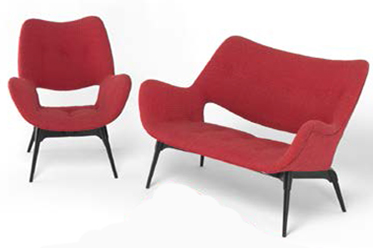 Mid-Century Modern: Australian Furniture Design is the first major exhibition dedicated to Australian furniture of the 1940s to the 1970s; a period of dynamic social change as Australians embraced modern ideals to encapsulate a new, cosmopolitan mode of living characterised by innovative and flexible furniture design.
Mid-Century Modern: Australian Furniture Design is the first major exhibition dedicated to Australian furniture of the 1940s to the 1970s; a period of dynamic social change as Australians embraced modern ideals to encapsulate a new, cosmopolitan mode of living characterised by innovative and flexible furniture design.
From Grant Featherston’s plywood Contour range and Clement Meadmore’s welded steel corded chairs, so distinctive of the 1950s, to Gordon Andrews’ elegant 1960s designs for home and office, mid-century furniture design turned its back on the overstuffed and ornate examples of previous decades and, in doing so, revolutionised the contemporary Australian interior.
Mid-Century Modern will showcase more than one hundred iconic pieces by these significant figures along with other key designers such as Douglas Snelling, Fred Lowen and Schulim Krimper, and present recreated interior vignettes including a full-scale living room based on the 1955 Age Dream Home.
“Mid-Century Modern will explore the influence of modern design upon the changing landscape of Australian furniture in the decades following World War Two,” says Tony Ellwood, Director, NGV.
“Furniture produced by local designers such as Featherston, Meadmore and Snelling is found in galleries and actively sought after by collectors across Australia today, showing its enduring influence and appeal.”
“Mid-Century Modern is the first major Australian survey to provide an in-depth look at this period, revealing how Australian furniture designers moved away from traditional, conservative pre-war styles and forged a new language of design that was innovative in its use of materials, functional and often imbued with a good dose of style.”
New methods of furniture design took hold in Australia after World War Two, prompted in part by the availability of new materials, and sometimes the shortages of others, the development of new production techniques and the influx of European immigrants who were skilled in the traditions of fine furniture making. Taking their cue from international trends in furniture, local designers adopted the pared-back language of modernism to create stylish and sculptural pieces, which found the ideal setting in the architecture of the period.
Mid-Century Modern also charts the dramatic changes that took place within Australian furniture design and manufacture across four decades, from a very modest industry in the post-war years which did its utmost to produce well-designed and affordable furniture and which, by the 1960s, was able to manufacture designs that catered to the local market as well as being exported in vast quantities.
Alongside these seminal modern furniture pieces, Mid-Century Modern will encompass designs by visual artists such as Robert Klippel and Janet Dawson who occasionally adapted their creative skills to the production of furniture, and examples of Fred Ward’s post-war do-it-yourself Patterncraft furniture. Contextual material including working drawings, textiles of the period and photographs of contemporary architecture will also be included, building a rich picture of this relatively little known aspect of Australia’s design history.
Mid-Century Modern: Australian Furniture Design
The Ian Potter Centre: NGV Australia, Federation Square, Melbourne
Exhibition: 30 May – 19 October 2014
Admission charges apply
For more information, visit: www.ngv.vic.gov.au for details.
Image: Grant Featherston (designer), Australia 1922–95, Emerson Bros Pty Ltd, Melbourne (manufacturer) (1930s –50s), B220H Curl-up Contour chair (1953), hardwood, plywood, cotton, (other materials), 94.0 x 85.1 x 82.5 cm, National Gallery of Victoria, Melbourne, Gift of Grant and Mary Featherston, 1973 / Grant Featherston (designer), Australia 1922–95, Unknown (manufacturer), Television BS211H Contour settee (1953), hardwood, plywood, cotton, 78.7 x 119.4 x 82.0 cm, National Gallery of Victoria, Melbourne, Gift of Grant and Mary Featherston, 1973
